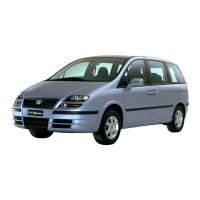
Do you have a question about the Fiat Ulysse and is the answer not in the manual?
| Brand | Fiat |
|---|---|
| Model | Ulysse |
| Category | Automobile |
| Language | English |
Instructions for correctly refueling the vehicle.
Procedures for starting the engine correctly.
Symbols indicating critical safety instructions for driver and passengers.
Symbols indicating hazardous components or situations.
Symbols indicating actions that must be avoided.
Symbols indicating potential risks or important information.
Identification of dashboard components and controls.
Explanation of the vehicle's electronic engine immobiliser system.
Description of the keys supplied with the car and their functions.
Proper procedure for fastening and unfastening seat belts.
How to adjust the seat belt height for optimal safety.
Explanation of the seat belt pretensioner system.
General safety guidelines for seat belt usage.
Critical safety advice regarding child transport and airbags.
Guidelines for using child restraints for infants up to 13 kg.
Guidelines for using child restraints for children weighing 9-18 kg.
Guidelines for using child restraints for children weighing 15-25 kg.
Guidelines for using child restraints for children weighing 22-36 kg.
Summary of safety rules for transporting children.
Instructions for installing Isofix child restraint systems.
How to fit child seats for Group 1.
Explanation of the odometer display and instrument panel controls.
Understanding the scheduled maintenance indicator and warning lamp.
Meaning of the red battery warning light.
Warning lights for handbrake and low brake fluid.
Meaning of the amber ABS warning light.
Meaning of red warning lights for EBD failure.
Meaning of the red engine coolant level warning light.
Meaning of the amber seat belt warning light.
Meaning of the amber EOBD warning light.
Meaning of the amber air bag malfunction warning light.
Meaning of the amber warning light for passenger airbag deactivation.
Meaning of the red service warning light.
Warning light for low tyre pressure or punctured tyres.
Warning light for a failure in the TPMS.
How to display and reset trip computer information.
Overview of the cruise control system and its general use.
Overview of the electronic automatic gearbox and its driving methods.
Explanation of the automatic gearbox selection lever positions.
Detailed procedure for starting the engine correctly.
Steps for safely moving the vehicle after starting.
What to do in case of electronic automatic transmission failure.
How to open and lock the tailgate from the outside.
Important advice for transporting luggage safely.
Step-by-step instructions for opening the bonnet.
Step-by-step instructions for closing the bonnet.
Importance and procedure for correct headlamp beam positioning.
Explanation of the Anti-lock Braking System and its operation.
Explanation of Mechanic and Hydraulic Brake Assistance systems.
How to activate and deactivate the ESP system.
How the ESP system signals its action and failure.
Explanation of Traction Control and Anti-Slip Regulation functions.
Explanation of the Tyre Pressure Monitoring System.
Description and operation of front airbags.
How front airbags function during an impact.
Details on the passenger front airbag and its design.
Procedure to manually deactivate the passenger airbag.
Purpose of side airbags and their types.
General safety notes and warnings regarding airbags.
How parking sensors detect obstacles and provide warnings.
Key considerations and recommendations for towing a trailer.
Recommendations and precautions for towing a trailer.
Instructions for refueling the vehicle correctly.
Instructions for starting the vehicle's engine.
Step-by-step guide to starting the vehicle's engine.
Procedures for parking the vehicle safely.
General tips for safe driving practices.
Essential checks and adjustments before driving.
Key advice for safe travel and passenger safety.
Recommendations for driving safely in rainy conditions.
Safety precautions for driving in foggy conditions.
Recommendations for driving safely on snow and ice.
How to maximize the benefits of the ABS system.
Importance of regular maintenance for vehicle longevity and performance.
Importance of maintaining emission control devices for performance and environment.
Steps to take when storing the car for extended periods.
Steps to follow when restarting the vehicle after long-term storage.
What to do if a tyre is punctured and how the system signals it.
General safety and usage instructions for the jack and spare wheel.
Detailed steps for changing a vehicle wheel.
General instructions and warnings for replacing burnt-out bulbs.
Important guidelines and precautions for changing bulbs.
Replacing bulbs in the front light cluster.
Replacing bulbs in the rear light cluster.
General information and warnings about fuse replacement.
General information and warnings about fuse replacement.
Locations of the vehicle's fuseboxes.
List of fuses located in the glove compartment fusebox.
List of fuses located in the fusebox near the battery.
List of fuses located in the engine compartment fusebox.
Recommended procedure and precautions for recharging the battery.
Instructions for jump-starting a vehicle's battery.
General instructions for using the vehicle's jack.
Instructions for attaching the tow hitch.
Steps to take and safety measures after an accident.
How to provide first aid and assistance to injured persons.
Importance of regular maintenance for vehicle longevity and performance.
Overview of the scheduled service operations and their frequency.
More frequent checks for vehicles used under heavy-duty conditions.
Safety warnings and procedures for checking fluid levels.
How to check and top up engine oil levels.
How to check and top up engine coolant.
How to check and top up brake and clutch fluid.
Procedure for replacing the vehicle's battery.
General Precautions.
How to check and maintain correct tyre pressure.
Advice on tyre replacement, care, and potential damage.
Advice on cleaning and changing wiper blades.
Step-by-step guide to changing windscreen wiper blades.
Identification of vehicle identification plates and their locations.
Detailed information provided on the model plate.
Table of engine specifications including displacement, power, and torque.
Information on the clutch, manual gearbox, and automatic gearbox.
Overview of the electronic automatic gearbox and its driving methods.
Information on service and emergency brakes, including ABS and EBD.
Details on service and emergency braking systems.
Description of front and rear suspension components.
Details on rev counter, speedometer, fuel, and coolant gauges.